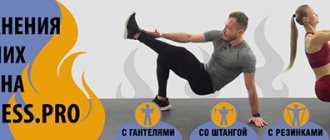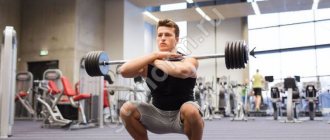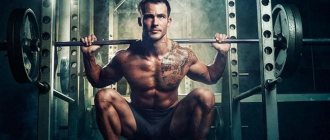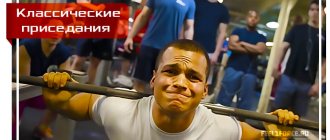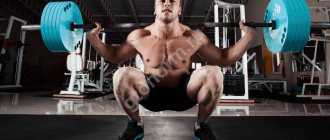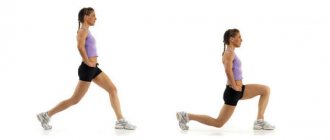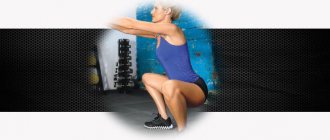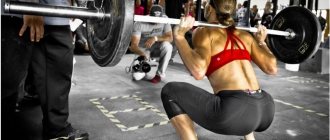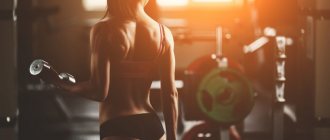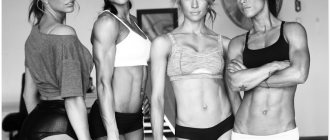The Plie squat is performed with a wide stance, which is where the name comes from. This exercise is a basic one and is aimed at specifically working out the internal muscles of the buttocks and thighs. It is performed without the use of any weights and is perfect for beginner athletes. The absence of weight resistance allows you to fully concentrate on muscle work and correct execution technique, increasing the effectiveness of exercises.
Execution technique
For the exercise to bring maximum benefit, it requires proper technique at each stage of execution.
Initial position
- place your feet as wide as possible, toes should point outward;
- fix the vertical position of the body so that it does not lean forward and the shoulders are not rounded.
- Hand position is not of primary importance. Your arms can be kept on your sides or extended in front of you.
Movement
- as you inhale, move down and count 1, 2 and 3 until your thighs are parallel to the floor or go down a little deeper;
- hold at the bottom point for a few seconds and feel how the muscles tense and stretch;
- as you exhale, return to the starting position, fully straightening your knee joints and straightening your legs;
Proceed immediately to the next rep. No pause is required between approaches.
Plie Squat Technique | Plie Squat [90-60-90]
Important details!
- During all approaches, you need to look at a distant imaginary point located above eye level. This technique allows you to control the correct location of the housing. The back should be perfectly flat, and a slight deflection should be maintained in the lumbar region.
- Performing plie requires the correct position of the knees, that is, similar to that followed in the classic version, so that the kneecaps do not extend beyond the line of the toes.
- To maintain tension in the muscle working groups, you should not strain your knee joints. At the top extreme point, the knees should be completely straightened.
- When difficulties arise with balance, the first lessons can be carried out with the use of support, which allows you to consolidate coordination skills.
Differences from classic squats and sumo squats?
Of course, comparing regular classic squats and plies is not entirely rational. These are two different exercises. Starting from the position of the legs. We are talking about the width of their production. In the classic version, place your feet shoulder-width apart. The feet are turned slightly to make the position more stable. And ending with the fact that the exercise occurs due to the work of the quadriceps, gluteal muscles and hamstrings. Leading agents are used to a minimum.
But sumo squats are often confused with plies. But these are two different exercises, and they have very significant differences.
- In plie squats, the width of the legs is much wider than in sumo style. This is done in order to stretch the adductor muscles as much as possible.
- In sumo style, the socks are slightly turned out to the sides for greater stability. While in plié we turn our feet 45°. Rotating the toe also affects the level of adductor stretch.
- Plie is performed with a straight back. This way we exclude the gluteal muscles from the exercise. And we can load the adductors as much as possible. In the sumo squat, the main areas for us are the buttocks and the back of the thigh. Therefore, we lean forward a little and push our pelvis as far back as possible.
- Plie squats are a more isolated exercise and don't require too much weight. But in sumo, you have to sweat with a heavy barbell on your shoulders or dumbbells in your hands.
As you can see, plie squats have nothing in common with other types of this exercise. So don't confuse them. And then you will be able to influence exactly those muscles that you planned.
Recommendations
- The load when performing the Plie squat should fall on the inner thighs. To achieve this, the feet must be kept turned outward as much as possible.
- The range of motion has a direct impact on the load on the gluteal muscles. The deeper you sit, the higher the effectiveness of the exercise.
Compliance with these important points allows you to achieve the correct execution of Plie and get maximum benefit.
Common mistakes when doing the exercise
In plie squats, the technique of performing the workout is important. Often, especially by beginners, the same mistakes are made, which can lead to unpleasant consequences and make training useless.
- Incorrect head position. Keep your head straight, chin slightly raised. The gaze is fixed on a point on the wall, just above eye level.
- Under- or over-rounded back. The body is kept straight, this rule especially applies to athletes doing squats with weights, in order to avoid a traumatic load on the spine.
- Unstable knee position. The reason is poor stretching and weak knee ligaments, or the legs are not spread wide enough. The knees do not protrude beyond the feet and are not brought to the center.
- The heels come off the floor. Such a defect leads to a shift in the center of gravity, which incorrectly distributes the load on the muscles.
- Not a deep squat. Works the outer thigh and quadriceps. A small range of motion negates efforts to pump up the buttocks and inner thighs. In a plie, squat as deeply as possible.
- Full straightening of the legs when lifting. Muscle relaxation leads to a decrease in the effectiveness of the workout, so to maintain tension, the legs are not fully straightened.
- Incorrect projectile weight. Too heavy equipment causes destabilization of balance and muscle strain.
This type of training is an effective type of exercise for strengthening the inner thighs and pumping up the gluteal muscles, provided that the correct technique is followed. It is especially common among girls who want to improve their body contours. With the use of weights, it is used by experienced athletes for proportional pumping of the legs.
Execution options
There are several variations of the wide-foot squat:
- Plie pulse when squatting with a small amplitude. Lower your hips to the horizontal, lift them up quite a bit and repeat again. In this way, the result is consolidated, that is, the target muscles are refined.
- Plie with emphasis on one leg , allowing you to redistribute the load. One leg is placed on the toe, and the other on the foot. This option is ideal for diversifying training and pumping up a specific leg.
- The toe plie is a variation of the exercise for well-coordinated and fit people. Only socks touch the floor. Not only the inner thigh muscles are involved in the work, but also the calves.
- On the calf muscles , when only the heel is lifted alternately from the lowest point. This exercise gives the calves a beautiful and well-developed relief.
- With a jump , when they jump at the top point. This variation has an aerobic component and trains the heart muscle well.
How to do plie squats correctly
Analysis of the exercise
What muscles work
The exercise is a classic variation of squats, which are classified as compound movements involving all the muscles of the lower extremities. The calf muscles, gluteus maximus, femoral muscles, including the bi- and quadriceps muscles, as well as the vastus medialis and sartorius, adductor muscles, take an active part in the work.
To control movements and maintain balance during the exercise, the soleus muscles and stabilizers are involved in the work. The role of the latter is performed by the press with back extensors.
Plie and classic squats: what is the difference
The main difference is the placement of the legs. When performing plie, the feet are wide apart and the toes are turned outward. Changing the position, technique and range of movements allows you to ensure that the load is directed to the inner thighs and gluteal muscles.
Difference between Plie and Sumo squats
Many people mistakenly confuse these two exercises with each other, but this is absolutely not true. When performing sumo, the pelvis is pulled back and the body is moved forward. This technique allows you to use a much larger load in the form of heavy weight.
“Plie” is performed with a strictly vertical position of the body and the pelvis is not pulled back so much. The muscles of the inner thigh are involved in the work. This is a completely different load distribution, so it’s impossible to say that these two squat options are the same.
Why do plie squats?
Wide-legged squats are an effective movement that complements the main exercise complex, which is designed to work and develop the muscles of the legs. They do not replace classic squats and can be included in the training program as a supplement. “Plie” can be used separately if it is necessary to increase and change the direction of the workload, as well as adjust the shape and increase the volume of a certain muscle group. High-quality loading of the target muscle group is accompanied by the development of stabilizing muscles of the abdominal and back muscles.
Varieties of Plie
The calisthenic variant with overcoming one’s own body weight is usually referred to as the “sumo” interpretation. There are many “power” versions that can significantly complicate squats. Such varieties allow you to increase the “press” load. You can use a kettlebell, t-bar, dumbbell, barbell.
Who is the exercise suitable for?
Representatives of the fair sex include squats with wide stance in their training. There is a completely reasonable explanation for this, so this choice is due to practicality.
Plie differs from the classic variation in that the movement reduces the pressure that the workload puts on the quadriceps and focuses on problem areas for women, which are quite difficult to work out when performing standard movements. These muscle groups include the gluteal and adductor muscles.
Squats with dumbbells between legs. Plie squats
Benefits of plie squats
- squats with a wide stance are among the few movements that allow you to load and work the inner thigh muscles, which are hard to reach;
- plie refers to exercises that allow you to work the inner surface of the thigh muscles;
- the knee joints are not overloaded due to the fact that the movement when performing plie is anatomically natural, but this is only true if the correct safety precautions are followed, which reduces the risk of injury;
- the exercise is great even for those athletes who have suffered a back injury, and they can even use weights, which is due to the specifics of the movement and position, which allows them to isolate the spine;
- the movement puts a complex load on a fairly large number of muscles;
- plie squats are well suited for both building and separating muscle mass in the lower part of the body;
- load variability when using different types of projectiles;
- increase elasticity and mobility of the articular-ligamentous apparatus.
Plie squats are suitable for performing both in the gym and at home.
How to make plie squats more difficult?
The standard technique of execution is classic, and the use of weights in the form of dumbbells, kettlebells, barbells allows you to complicate the exercise. This is not the only way available to improve the efficiency of the basic movement. You can make squats more difficult by doing the following:
- The deeper you squat, the more load your gluteal muscles receive. How to achieve this? You can use a step platform, plates or plinths placed under each leg. This option is not suitable for everyone. It is recommended for people with high hip flexibility.
- Raising at the top point of the movement, that is, when returning to the starting position. This allows you to pump your ankle and develop your calf muscles even more. This approach to performing the exercise significantly increases the load.
These two options allow you to diversify your workout and further work out hard-to-reach areas of the leg muscles.
The benefits and harms of goblet lunges
So, we have looked at the technique of performing goblet squats, and then we will find out why they are so useful:
- Contribute to the formation of a beautiful figure in the buttocks and hips;
- Allows you to effectively load the abdominal muscles;
- Gives muscle tone and allows you to develop a sense of endurance;
- They help establish the correct technique for classic squats;
- Helps improve posture;
- With the correct technique, joint mobility is developed;
- Athletes who do not have the opportunity to go to the gym will be pleased with the versatility of the exercise, because it can be performed at home using a handy weight - a jar with sand, a dumbbell, etc.
Can goblet squats cause harm?
- They will not help you pump up a lot of volume, so athletes who work hard to do them will only get tired in vain. Yes, they will become more resilient and tone their muscles, but in order for them to grow, they need to work with heavier weights.
- If the technique of performing squats with a kettlebell is not followed, there is a risk of injury to the knees, back, and ankle joints;
- Also, the exercise can harm the body if you practice it in the presence of contraindications:
- Injuries and diseases of the ligaments and joints of the legs and arms;
- Diseases of the musculoskeletal system;
- Severe pathologies of the cardiovascular system;
- Pregnancy;
- After a heart attack and stroke;
- Glaucoma;
- After abdominal operations;
- Feeling unwell, headache;
- Inflammation, colds, elevated body temperature;
- Exacerbation of chronic diseases;
- Etc. (we hope for your prudence).
Well, now you know how to do goblet squats with a kettlebell, we hope they will take a strong place in your training program. If for some reason you cannot practice them, try replacing them with front squats with a barbell, hack squats, Smith machine squats, deadlifts, machine leg raises, and leg presses. When choosing an alternative, consider how you feel and the reason why you cannot do goblet squats.
Introducing an exercise into a training program
Plie squats are basic movements for the gluteal and calf muscles. It is recommended to perform the movement at the beginning of the lesson, but after a good warm-up. It is very useful and perfectly complements lunges or leg presses. The number of repetitions depends not on the level of training, but on whether additional weights are used:
- a large number of repetitions (15-20 times) with load variability, which is entirely determined by the athlete’s own level of training;
- power squats cannot have the same repetition rate and are performed 8-10 repetitions or 10-50 in 4-5 approaches, when the muscles are given relief.
Plie squats can be used as finishing movements to complete a workout. In this variation, they are performed to complete failure, and no weights are used.
Weights: to use or not?
The use of sports equipment helps the athlete regulate the load level and achieve real training stress. This is a fairly effective and profitable technique, which largely allows you to achieve the goals set for the athlete.
High and peak loads are not suitable for everyone. For some athletes, weights are contraindicated. This applies to people with injuries to the hip and knee joints, spine, and so on. They cannot perform squats using implements.
Plie squats according to the rules
In order for the exercise to bring maximum benefit, the following points must be taken into account:
- The legs should be wider than the shoulder girdle, and the toes should be spread to the sides. The direction of the toe sets the vector of movement of the knee joint.
- The knees are directed towards the toes. The left one “looks” to the left, and the right one “looks” to the right.
- The body is fixed strictly vertically, so when moving you must be sure to monitor this moment.
- Plie power squats are performed smoothly and at a slow pace, controlling every movement.
- The gaze should always be straight and the chin raised.
- Returning to the starting position requires “switching off” the knees, that is, they remain bent until the very extreme point.
What muscles work?
Exercising with additional weight uses muscles.
- quadriceps;
- biceps and shoulder girdle;
- soleus;
- deltas;
- hamstring biceps;
- rectus abdominis;
- calf and gluteal.
Kettlebell squats, also known as goblet squats, or goblet squats, are an excellent exercise for developing the muscles of the thighs and buttocks.
